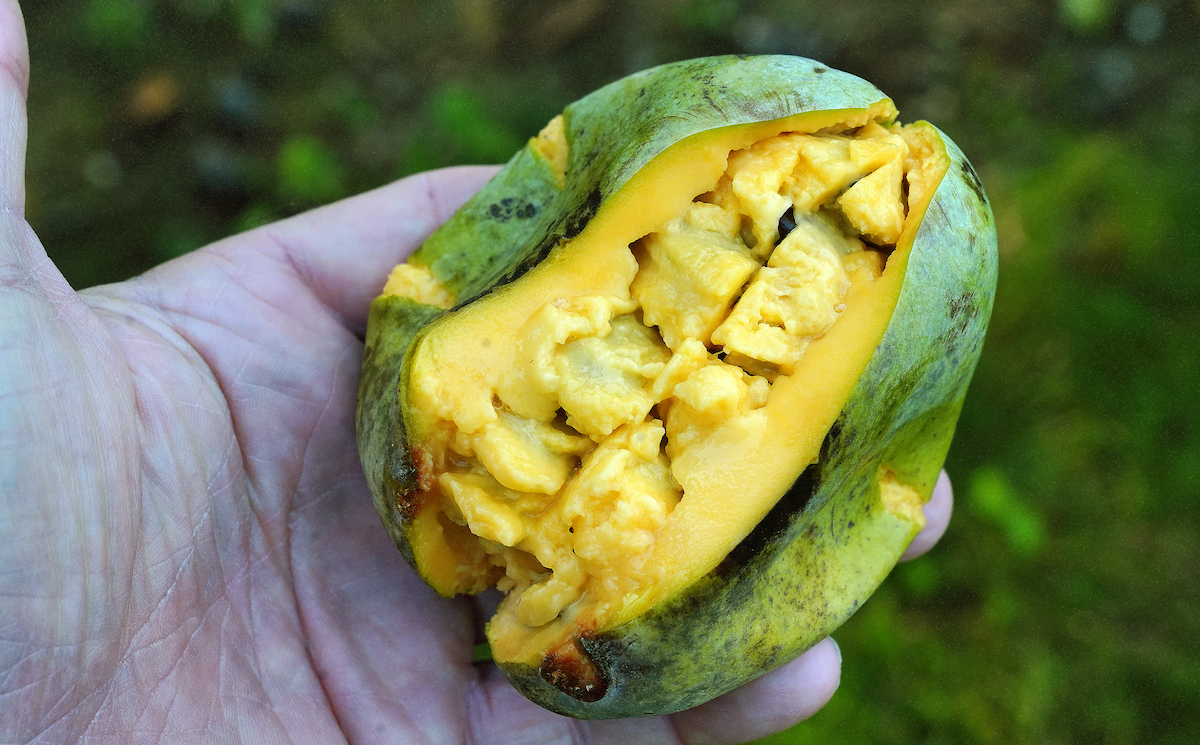Pawpaw – the Indiana Banana?
The winter months give us a little extra time to think about new things, including our home landscape for the coming year. Some people have installed backyard orchards, choosing the more typical fruit varieties you might find in Indiana, including apple, pear or tart cherry. Have you heard of the pawpaw tree?
Rosie Lerner, recently retired Purdue University consumer horticulture specialist, wrote about pawpaws. I have always heard it referred to as the Indiana Banana or the Hoosier Banana, but are these epithets entirely accurate?
“The pawpaw has been called the Hoosier Banana, but probably only by Hoosiers themselves,” she said. “The same plant is also known as the Michigan Banana, Kentucky Banana and other regional favorites.” Lerner’s article title seemed to question whether it should be called the Midwest Banana.
Pawpaw is a native tree of Indiana, found growing in low woods, and along rivers and streams in much of Indiana and the Midwest, with the heart of its territory in the Ohio Valley. They are primarily found as understory trees, meaning that they grow beneath the main canopy of the forest (under the partial shade of taller trees). Pawpaw root-suckers freely and can form small colonies of trees.

The pawpaw tree grows to a pyramidal form in full sun.
The fruit does have a flavor somewhat like a banana, although others have described the taste as similar to mango. The fruits are greenish-yellow berries, which turn brownish-black when fully ripe. Fruit can vary considerably in size, having an oblong to round shape. I would describe the fruit as resembling a stubby, rounded banana.

The pawpaw fruit cut open reveals the yellowish flesh inside, with seeds in the center.
In the Purdue Extension publication, “Growing Pawpaws,” author Bruce Bordelon described the relative difficulty of getting new pawpaws established.
“Although the pawpaw is capable of fruiting in the shade, it performs best on sites with full-sun exposure, but with some protection from wind (because of its large leaves),” he said. “Seedlings, however, will not survive under full sun conditions because the young shoot is extremely sensitive to sunlight.” He said that shading for the first year, and sometimes the second, is usually required.
Bordelon said the pawpaw is very difficult to transplant. “It would seem natural to propagate a clone by transplanting rootsuckers, since pawpaws commonly sucker from the roots, but in practice this is extremely difficult and usually ends in failure,” he said. “Seedling trees, on the other hand, have been successfully transplanted.” Bordelon suggested planting in the spring at the time that new growth commences or soon after.
Some may desire to transplant pawpaw from a woodland. Bordelon said the key to successful transplanting from the wild lies in five rules:
- Transplant seedlings for best results.
- Keep the roots and soil intact as much as possible.
- Transplant in the spring after budbreak, not in fall or winter.
- Plant in a well-drained site, and keep trees well-watered the first year.
- Provide partial shading for the first year or two.
Pawpaws are available from nurseries as bare-root and container-grown trees.
Once established, the pawpaw is vigorous and easy to maintain. Fruit production may begin after about five to seven years.
Lerner described potential issues with fruit set in pawpaws. “Some backyard growers complain of poor fruit set on their pawpaws,” she said. “There is still some controversy over which insects are the primary pollinators.” Lerner described possible pollinators that may include honeybees, carrion flies, or a species of beetle. “The flowers do have a very rank odor, so flies and beetles are the more likely bets,” she said.
“Additionally, self-pollination does not occur within a flower so other flowers must be nearby to provide a pollen source,” she said. “Planting several trees should help provide sufficient flowers.”
For additional information, find Lerner’s original article at https://www.purdue.edu/hla/sites/yardandgarden/pawpaw-the-midwest-banana/. Find Bordelon’s Purdue Extension publication on growing pawpaws at www.edustore.purdue.edu. Find suggestions on the uses of pawpaw fruit at: https://extension.purdue.edu/foodlink/food.php?food=pawpaw.
